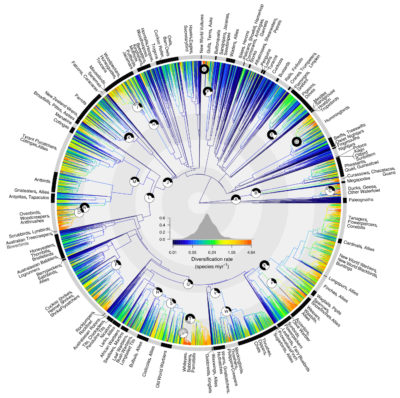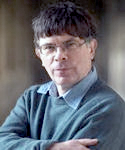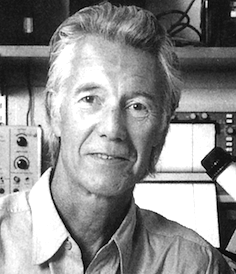 Scientists last week proposed new evolutionary relationships among all 9,993 of the world’s known living bird species. In a letter published in the prestigious Nature journal, scientists reported on the use of DNA-sequence data to create a radiating phylogenetic tree, a revolutionary new bird tree of life (pictured left).
Scientists last week proposed new evolutionary relationships among all 9,993 of the world’s known living bird species. In a letter published in the prestigious Nature journal, scientists reported on the use of DNA-sequence data to create a radiating phylogenetic tree, a revolutionary new bird tree of life (pictured left).
Walter Jetz (pictured right), an evolutionary biologist at Yale University in New Haven, Connecticut, was the leading author of the letter entitled “The global diversity of birds in space and time.” In an interview with science writer Virginia Gewin for Nature News, Jetz explains –
“This is the first dated tree of life for a class of species this size to be put on a global map.”
Phylogenomic Study
The construction of the new bird tree of life used the phylogenomic data published in the journal Science in 2008. By dividing the birds into 158 clades and using ten fossils, the researchers dated and placed all the living species on the tree, starting with roughly 6,600 for which genetic information was available.
Even Gewin, however, raised a red flag in Nature News, noting the “endeavor is also controversial, owing to the large number of species for which no [DNA] sequence data are available.”
Robert E. Ricklefs, of the University of Missouri-St. Louis commented in the journal Nature, lent a measure of credence to the study, noting –
“The result is perhaps not perfect, but it is probably the best possible for now.”
 Mark Pagel of the University of Reading, UK, gave the counter-opinion in the journal Nature, noting –
Mark Pagel of the University of Reading, UK, gave the counter-opinion in the journal Nature, noting –
“If the phylogeny is wrong, it might confidently return biased or misleading answers to tests of evolutionary questions.”
Trevor Price, an evolutionary biologist at the University of Chicago in Illinois, in an interview with Gewin, weighed in on the scientific value of the study, noting –
“This is a conceptually brilliant attempt to link space with time while crafting a complete phylogeny. But there are almost certainly introduced artifacts by lacking one-third of the sequences used to create it.”
Jetz’s team found evidence of rapid speciation that has increased over time. Biologist and co-author Arne Mooers, of Simon Fraser University, Canada, explains –
“The current zeitgeist [thought] in biodiversity science is that the world can fill up quickly… Speciation is actually speeding up, not slowing down.”
Unlike other tree-of-life schemes, Jetz’s new bird tree of life is a radiating circle rather than a branching tree originating from a single ancestral trunk. Reports on Jetz’s paper received widespread coverage, including ScienceDaily, ScienceNews, and the Sierra Club.
The paper was sub-titled “Ambitious attempts to link geography to diversification ruffle some feathers,” to highlight the revolutionary aspect of the new bird tree of life shape.
The structure of the new bird tree of life scheme is more complicated than a typical tree. Whether Jetz’s tree will stand the test of time within the evolution industry is pending. As Jetz explained to Gewin –
“This is certainly not the last word on the phylogeny of birds. We hope it will trigger additional efforts to continue improving our understanding of the avian tree of life.”
Molecular Biology vs. Darwin
Twenty-first-century scientists are discovering Darwin’s predicted: “slight successive” driven by natural selection over long periods to be a fossil record rare bird. As molecular biologist Michael Denton in the book Nature’s Destiny, How the Laws of Biology Reveal Purpose in the Universe, notes –
“In the current molecular biological picture of life, we have found a ‘watch’ more complicated and more harmonious than any conceived by William Paley.”
As an eighteenth-century naturalist, Paley is best known for his exposition of the teleological argument for the existence of God in his work entitled Natural Theology, using the designer watchmaker analogy. Early in life, Darwin read Paley passionately, then gradually turned adamantly against him.
English paleontologist Simon Conway Morris (pictured right), commenting on the limits of molecular biology in the journal Nature (1995), sees the flight path of Darwin’s emerging dilemma –
“The story emerging from molecular biology is that what may look very different in anatomical terms can be founded on a basically identical gene architecture.”
With vast differences in anatomy and physiology, it is surprising to find broad molecular similarities that exist throughout nature. Sensing the on-the-wall, Lynn Margulis, the 1999 winner of the National Medal of Science, awarded by President William J Clinton, referring to the Altenberg-16 Summit, said –
“Everyone agreed with the ultimate common ancestry of Earth’s life because the DNA, RNA, messenger, transfer RNA, membrane-bounded cell constituents (lipids, the phospholipids) that we share—they’re all virtually identical in all life today.”
 Brian Goodwin (pictured left), a theoretical biologist at the University of Edinburgh, Scotland, as a free-thinking evolutionist, advances a revolutionary idea –
Brian Goodwin (pictured left), a theoretical biologist at the University of Edinburgh, Scotland, as a free-thinking evolutionist, advances a revolutionary idea –
“Genes are responsible for determining which molecules an organism can produce; the molecular composition of organisms does not, in general, determine their form.”
The genetic evidence from birds paints a discontinuous mosaic pattern. The new bird tree of life underscores persistent problems with Darwinism and the Modern Evolutionary Synthesis theory. Darwin’s Dilemma intensifies.
Genesis
The phylogenetics of the new bird tree of life stands as evidence supporting the Genesis account as recorded by Moses, but not as evidence of evolution, intensifying Darwin’s dilemma. Max Planck, a German theoretical physicist, was awarded the Nobel Prize in Physics in 1918 for developing the theory of quantum mechanics during the Scientific Revolution –
“Yet in the whole of the universe, there is no force that is either intelligent or eternal, and we must therefore assume that behind this force there is a conscious, intelligent Mind or Spirit. This is the very origin of all matter.”
Evidence from molecular biology underscores why the theory of evolution remains speculative but not scientifically valid.
New Bird Tree of Life is a Molecular Biology article.
Darwin Then and Now is an educational resource on the intersection of evolution and science, highlighting the ongoing challenges to the theory of evolution.
Move On
Explore how to understand twenty-first-century concepts of evolution further using the following links –
-
- The Understanding Evolution category showcases how varying historical study approaches to evolution have led to varying conclusions. Subcategories include –
- Studying Evolution explains how key evolution terms and concepts have changed since the 1958 publication of The Origin of Species.
- What is Science explains Charles Darwin’s approach to science and how modern science approaches can be applied for different investigative purposes.
- Evolution and Science feature study articles on how scientific evidence influences the current understanding of evolution.
- Theory and Consensus feature articles on the historical timelines of the theory and Natural Selection.
- The Biography of Charles Darwin category showcases relevant aspects of his life.
- The Glossary defines terms used in studying the theory of biological evolution.
- The Understanding Evolution category showcases how varying historical study approaches to evolution have led to varying conclusions. Subcategories include –
2020 Update
To date, the use of a phylogenetic approach to developing a tree of life for birds is not widely adopted.
- According to WIKIPEDIA (2020),
In the article entitled Evolution of Birds does not discuss Jetz’s phylogenetically derived tree of life.
- Evolution 101 of the University of California, Berkeley, does not discuss Jetz’s phylogenetically derived tree of life.
- The Smithsonian Institute does not discuss Jetz’s phylogenetically derived tree of life.



